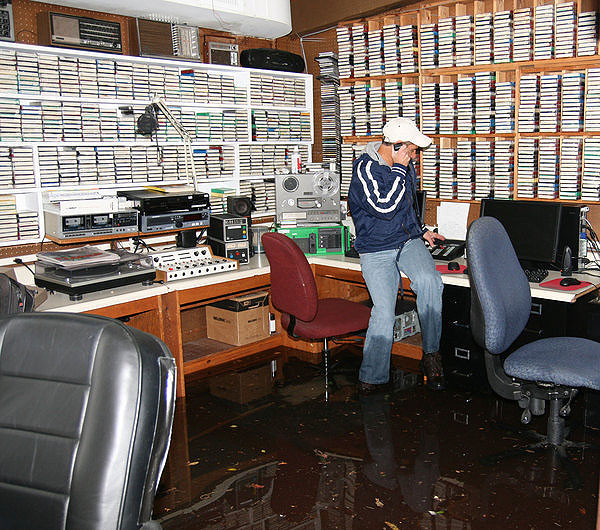
Last Monday, October 29, most people were already home (or wanted to be), hunkered down and anxiously awaiting Hurricane Sandy. But many local radio personalities, including Gary Sapiane of WLNG and Bonnie Grice of WPPB, were in the studio, on air and broadcasting live.
At one point, Mr. Sapiane, the president and general manager of Sag Harbor-based WLNG 92.1 FM, and his coworkers David Kline and Brian “The Cannon” Bannon, were at the studio, standing ankle-deep in water, taking calls from listeners and reading the news with the aid of a flashlight since the electricity had gone out and the station was being powered by a single generator.
Many listeners thought that the WLNG staff was joking around and using sound effects when they heard sloshing water noises during the broadcast. But the water was real, Mr. Sapiane said of the storm surge that began flooding the waterfront Redwood Causeway radio station.
“About 2 o’clock or so, water starting coming into the station. It wasn’t too bad, just a little water came in and it was slightly wet,” he recalled during an interview at his storm-damaged studio on Friday. “Then water started coming in and never had a chance to recede ... At 6 o’clock we were in ankle-deep water. We stayed on the air until 8 o’clock and we could have continued but we had a generator on and something started to smell like it was burning. We thought that for our own safety, and also since the first responders were so busy, that they didn’t really need to come and bail us out of here.”
Mr. Sapiane reported that WLNG, which has been broadcasting for 50 years, was off-air from 8 p.m. on Monday night until 3 a.m. on Tuesday morning: an unusual circumstance as the station has been flooded only twice before—first in 1978 and then again in 1992—but managed to stay on air during each of the previous breaches.
“I’m amazed we were able to stay on the air as long as we did,” Mr. Sapiane said, adding that he knew that the station was in trouble when he couldn’t see the wooden dock moored out behind the building. “The water went out but we were sloshing for days,” he continued, pointing to a mess of seaweed and debris piled up on a back deck behind the building.
By Friday afternoon, the water-damaged carpet that had previously covered the station’s floors had all been ripped up and was laying in piles in the parking lot in front of and the deck behind the building.
“We got the power back yesterday. It was a nice way to kick off our 50th anniversary on the air,” Mr. Sapiane laughed. “Next year, we’ll have new floors. And no more rugs. It will all be tile.”
Over in Southampton Village, Hill Street stayed high and dry but winds eventually took their toll on the broadcast coming from 88.3 WPPB, which never lost power but did lose the internet connection to its transmitter at the Stony Brook Southampton campus during the night on Monday, according to Ms. Grice.
But the staff made the most of the day, she said.
“We planned on doing a regular show on Monday but I came in and decided to blow all of the regular programming and start talking with people, catching up with people,” she explained, adding that some of her on-air guests that day included Southampton Town Supervisor Anna Throne-Holst, East Hampton Town Supervisor Bill Wilkinson and a handful of news reporters.
“We were able to stay on air all day Monday and we were so proud of that,” said the award-winning broadcaster, producer, host and interviewer. “When I came in on Tuesday, no show. But what we were able to do was tape interviews and have Kyle Lynch [the station’s audio engineer] drive up to the transmitter and then load it into the computer so that it could be broadcast.”
In addition to the taped interviews, national programming and Sandy updates aired via National Public Radio, with which Peconic Public Broadcasting is affiliated. There was “no dead air,” Ms. Grice said, because of the network programming and national feed. The station was back on air, live and local, on Friday at 7 a.m. with morning man Michael Mackey.
During the hours leading up to the near-miss hurricane, Ms. Grice said that even though New York State Governor Andrew Cuomo had mandated on Monday morning that everyone not designated an emergency worker should be safe at home, the coming storm did not daunt her.
“When I get into the studio and by a microphone, I don’t get scared,” she said. “It takes all the fear and emotion right away. The microphone, for me, it’s been like therapy. It’s my driving force. As soon as the mic goes on, it’s like everything else gets obliterated.”
There was no question about staying on the air as long as was necessary, she continued.
“My mission and my role is to provide information,” she said, leaning into the microphone, forgetting for a moment that she was talking to a live interviewer and not to thousands of radio listeners. “We are back. Like the Phoenix rising from the ashes. Yep, that’s us—the little station that could.”
Peconic Public Broadcasting President, Dr. Wallace Smith, a founding board member of American Public Radio and one of the architects of National Public Radio, said that listeners remember why radio is so important when in the throes of catastrophe.
“Radio is still the most accessible, reliable information and entertainment service that we have,” he said, adding that the “content provider” and “virtual gathering space” is a “community center” destination to hear local voices, friends, news and entertainment.
He also remarked that even without electricity or the internet, everyone can get something out of the easily accessed medium.
“In an emergency situation, anybody can put a battery in a radio,” he laughed.